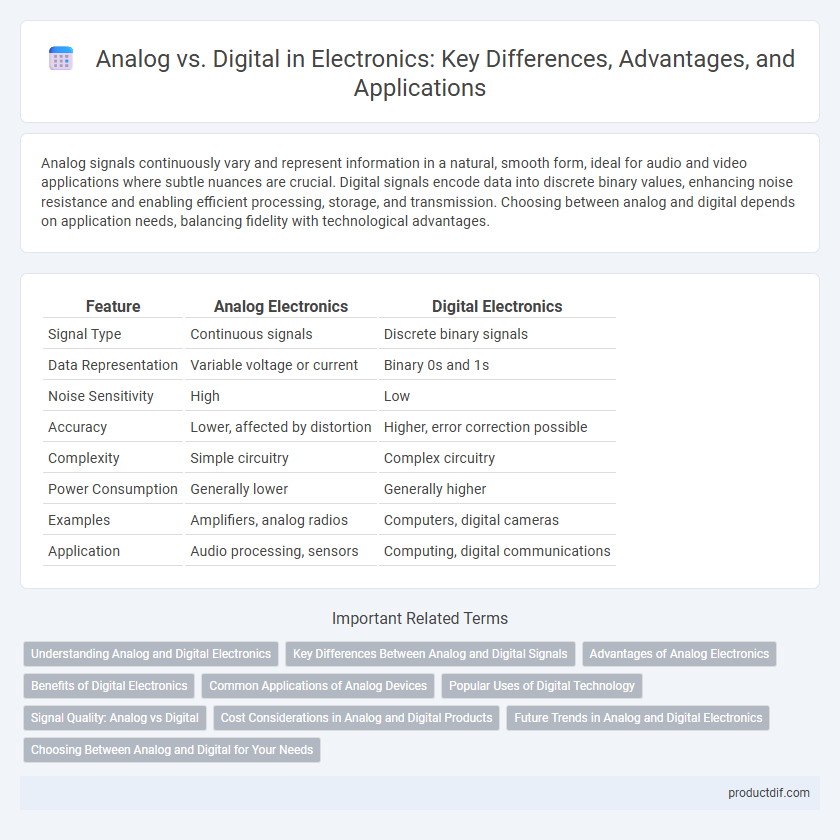Analog signals continuously vary and represent information in a natural, smooth form, ideal for audio and video applications where subtle nuances are crucial. Digital signals encode data into discrete binary values, enhancing noise resistance and enabling efficient processing, storage, and transmission. Choosing between analog and digital depends on application needs, balancing fidelity with technological advantages.
Table of Comparison
| Feature | Analog Electronics | Digital Electronics |
|---|---|---|
| Signal Type | Continuous signals | Discrete binary signals |
| Data Representation | Variable voltage or current | Binary 0s and 1s |
| Noise Sensitivity | High | Low |
| Accuracy | Lower, affected by distortion | Higher, error correction possible |
| Complexity | Simple circuitry | Complex circuitry |
| Power Consumption | Generally lower | Generally higher |
| Examples | Amplifiers, analog radios | Computers, digital cameras |
| Application | Audio processing, sensors | Computing, digital communications |
Understanding Analog and Digital Electronics
Analog electronics process continuous signals that vary smoothly over time, making them ideal for applications requiring precise signal representation such as audio amplification and temperature sensing. Digital electronics handle discrete binary signals, enabling error detection and correction, which is crucial for computing, data storage, and communication systems. Understanding the fundamental differences in signal representation and processing methods between analog and digital electronics is essential for designing efficient circuits and optimizing performance across various electronic devices.
Key Differences Between Analog and Digital Signals
Analog signals represent data through continuous waveforms that vary smoothly over time, capturing an infinite range of values, whereas digital signals encode data as discrete binary values, typically 0s and 1s. Analog signals are more susceptible to noise and distortion, which can degrade signal quality, while digital signals offer greater noise immunity and easier error detection and correction. The bandwidth and data transmission efficiency also differ, with digital signals enabling higher data compression and reliable long-distance communication compared to analog signals.
Advantages of Analog Electronics
Analog electronics offers superior signal resolution and continuous data representation, enabling more precise measurements in audio and sensor applications. Its ability to process real-world signals without requiring conversion enhances response time and reduces latency in control systems. Furthermore, analog circuits typically consume less power and exhibit simpler design structures, making them cost-effective for specific low-frequency applications.
Benefits of Digital Electronics
Digital electronics offer increased noise immunity, enabling accurate signal processing even in the presence of electrical interference. The scalability of digital circuits allows for complex logic implementations and easy integration with microprocessors, enhancing system functionality. Moreover, digital systems provide easier data storage, processing, and error detection, resulting in improved reliability and performance compared to analog counterparts.
Common Applications of Analog Devices
Analog devices excel in applications requiring continuous signal processing such as audio amplifiers, radio receivers, and temperature sensors, where signal fidelity and real-time response are critical. These devices are commonly used in instrumentation, medical equipment like ECG machines, and analog audio devices for precise measurement and smooth waveform reproduction. Their ability to handle variations in voltage and current makes them essential in control systems and analog signal conditioning.
Popular Uses of Digital Technology
Digital technology dominates in computing, telecommunications, and consumer electronics due to its superior accuracy, noise resistance, and ease of data storage and manipulation. Devices like smartphones, laptops, and digital cameras rely on binary signals to process and transmit information efficiently. Digital systems also enable advanced applications such as artificial intelligence, cloud computing, and high-definition multimedia streaming, driving innovation across industries.
Signal Quality: Analog vs Digital
Analog signals offer continuous waveforms that capture subtle variations in sound or light, preserving nuances in signal quality but are more susceptible to noise and interference. Digital signals encode information in discrete binary formats, providing greater resistance to noise and consistent signal integrity over long distances. This digital robustness leads to clearer, more reliable transmission and improved overall signal quality.
Cost Considerations in Analog and Digital Products
Analog products typically incur higher manufacturing costs due to precise component requirements and sensitivity to environmental variations. Digital products benefit from economies of scale and standardized integrated circuits, reducing unit costs significantly. However, complex digital signal processing can increase development expenses despite lower production costs.
Future Trends in Analog and Digital Electronics
Future trends in analog and digital electronics indicate a growing integration of both domains, leveraging advancements in semiconductor technology and signal processing. Analog circuits are evolving with enhancements in precision, low power consumption, and noise reduction, critical for applications in IoT devices and biomedical sensors. Digital electronics continue to advance through AI-driven design automation, increased data processing speeds, and energy-efficient architectures, driving innovation in computing, communications, and consumer electronics.
Choosing Between Analog and Digital for Your Needs
Selecting between analog and digital electronics depends on the specific application requirements such as signal accuracy, noise tolerance, and processing complexity. Analog systems excel in continuous signal representation with high fidelity for audio and sensor data, while digital systems offer superior noise resistance, easier data manipulation, and integration with modern computing technologies. Evaluating factors like cost, precision, and environmental conditions guides the optimal choice for reliable and efficient electronic design.
Analog vs Digital Infographic

 productdif.com
productdif.com